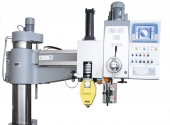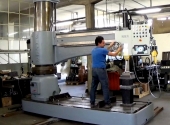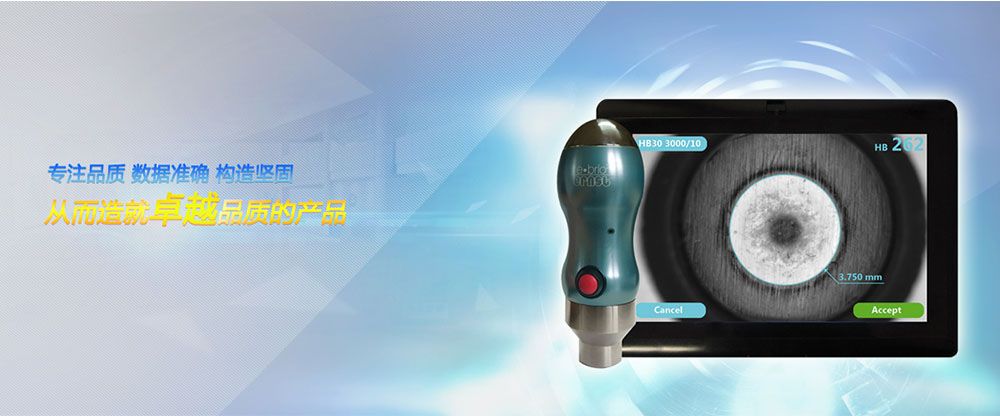|  |  |
![]() BRE-AUT BRG-SP.pdf 下载附件
BRE-AUT BRG-SP.pdf 下载附件
![]() BRE-AUT BRG 2015.mp4 观看视频
BRE-AUT BRG 2015.mp4 观看视频
Brinell hardness tester model BRE-AUT BRG-SP, special execution without milling unit for preparation of the test point, for testing specimens up to 1300 mm height, depth capacity 1.200 mm.
The BRE-AUT BRG-SP meets the norms ASTM E 10-12 and EN 6506-2
The equipment consists of:
A- Supporting column with adjustable height of the slide*
B- Rotating arm with measuring head for Brinell hardness testing*
C- Hydraulic station and cylinder
D- Electronic box
E- Standard accessories
Test Forces
3000 kgf (29430 N) e 750 kgf (7357 N)
Hardness
Measurable range 125 to 600 HB/30, indentation reading through Ernst E-BRIO Brinell optical reading system.
Surface preparation
The surface preparation will be done by the operator. The surface preparation device is not part of the hardness tester.
Power supply
400 V. 3-fase 50 Hz. Other power supply can be specified with the order.
Test temperature
Up to 50°C for the pieces
Operating temperature
0-50°C
Description of the single parts:
A- Supporting column with adjustable height of the slide
Radial drill structure, properly dimensioned for applying a maximum test load of 3000 kgf
Maximum measurable height: 1300 mm
Depth: 1200 mm
B- 180° rotating arm for loading and unloading of the test pieces with built-in measuring test head for Brinell hardness testing (B1-B2).
NOTE: The rotating arm allows the positioning of the samples to be measured on the base of the hardness tester without possibility of collision in loading and unloading.
B1 – Surface preparation unit:
Not included
B2- Cylinder and test head
The cylinder and test head assembly has an adjustable stroke according to the thickness of the test piece.
The test head stroke is about 300mm length. The system consists of an hydraulic cylinder with main steel shaft. The role of the cylinder is to automatically draw up the test head and apply the test load.
BRE AUT test head: the test head can perform tests up to 50°C
The role of the test head is to measure the hardness. The test load can be constantly controlled on the dial indicator situated in the middle of the test head or if needed with a load cell.
The core part of the instrument is the load cell at elastic deformation.
IMPORTANT:
The unique safety feature ERNST patent of the BRE-AUT series helps prevent injury by retracting instantly the penetrator when this makes contact with soft materials, such as the operator’s hands.
C- Hydraulic station and hydraulic cylinder
Standard execution for machine tools. It works with hydraulic cylinder supporting the test head. Tank capacity: 50 liters, with oil replacement every 3000 hours operation.
Hydraulic components with Rexroth/Parker electro valves and Parker cylinders.
D- Control console
Includes the E-BRIO Brinell automatic reading system, all general controls and the electric plant having the required voltage and safety characteristics. Suitable to operate at temperature from 0 to 50°C.
Siemens and Telemecanique components, except for the parts pertaining to the electronics of measure, which have been widely tested by us and guarantee extreme reliability.
E – Standard accessories
1- standard anvil for calibration of the tester with reference test blocks
2- Yamamoto test block with certificate
3- Indenters 10 and 5mm diameter
4- operation manual
The following items are part of the supply:
1) plans for installation of the machine
2) foundation plans
3) plan of the machine
4) electric and hydraulic drawings
5) list of recommended spare parts
Example of a test sequence
1.The test piece is positioned under the hardness tester by the customer’s loading system like fork or gantry crane etc.
The arm of the hardness tester can be rotated at 180° to allow the operator positioning the test part and avoid any possible collision with the hardness tester.
2. Once the test surface has been duly prepared by the operator using an external device (not included), the operator rotates the hand wheel to move the slide and place the measuring test head on the prepared area.
3.The test head moves down on the piece. The load is applied and the indentation is made. The E-BRIO camera is manually placed on the indentation to read the hardness.
It is possible to move down the measuring head step-by-step to make the indentation in one defined area of the piece of the test block.
4. The Brinell hardness is displayed on the PC screen along with indentation and tolerances; the final result is printed out.
5. Then, the test head returns to the home position.
B.图片和视频
|

